ACC/ACF2200 Management Accounting: Cost Analysis for RealFood Ltd
VerifiedAdded on 2023/06/04
|6
|1750
|336
Report
AI Summary
This report provides a detailed analysis of cost classifications and costing techniques applicable to RealFood Ltd, a small company competing in the healthy breakfast and snack industry. It explores the value of cost classifications, such as fixed, variable, direct, and indirect costs, and how these classifications can assist the CEO in improving decision-making processes related to budgeting, efficiency measurement, and cost control. Various costing techniques, including marginal costing, direct costing, absorption costing, and activity-based costing, are examined, with a recommendation for RealFood to use absorption costing due to its standardized product ingredients and the need to allocate both variable and fixed costs. The report also discusses how effective cost tracking and allocation can enable RealFood to budget effectively, plan for profits, and set competitive prices in the market. The importance of accurate record-keeping and the potential benefits of hiring a full-time accountant are also highlighted to ensure accurate cost classification and costing for different product types and client orders.
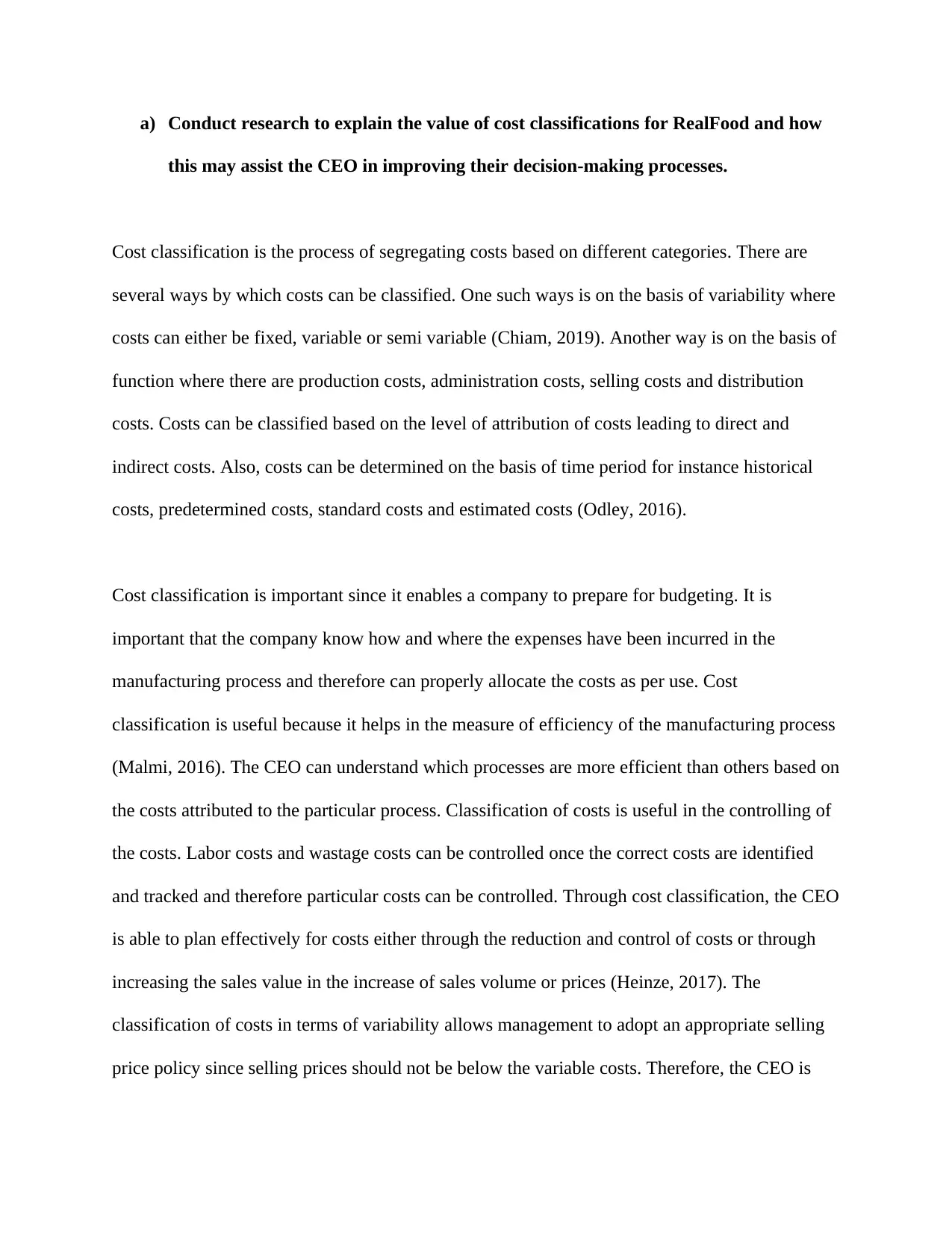
a) Conduct research to explain the value of cost classifications for RealFood and how
this may assist the CEO in improving their decision-making processes.
Cost classification is the process of segregating costs based on different categories. There are
several ways by which costs can be classified. One such ways is on the basis of variability where
costs can either be fixed, variable or semi variable (Chiam, 2019). Another way is on the basis of
function where there are production costs, administration costs, selling costs and distribution
costs. Costs can be classified based on the level of attribution of costs leading to direct and
indirect costs. Also, costs can be determined on the basis of time period for instance historical
costs, predetermined costs, standard costs and estimated costs (Odley, 2016).
Cost classification is important since it enables a company to prepare for budgeting. It is
important that the company know how and where the expenses have been incurred in the
manufacturing process and therefore can properly allocate the costs as per use. Cost
classification is useful because it helps in the measure of efficiency of the manufacturing process
(Malmi, 2016). The CEO can understand which processes are more efficient than others based on
the costs attributed to the particular process. Classification of costs is useful in the controlling of
the costs. Labor costs and wastage costs can be controlled once the correct costs are identified
and tracked and therefore particular costs can be controlled. Through cost classification, the CEO
is able to plan effectively for costs either through the reduction and control of costs or through
increasing the sales value in the increase of sales volume or prices (Heinze, 2017). The
classification of costs in terms of variability allows management to adopt an appropriate selling
price policy since selling prices should not be below the variable costs. Therefore, the CEO is
this may assist the CEO in improving their decision-making processes.
Cost classification is the process of segregating costs based on different categories. There are
several ways by which costs can be classified. One such ways is on the basis of variability where
costs can either be fixed, variable or semi variable (Chiam, 2019). Another way is on the basis of
function where there are production costs, administration costs, selling costs and distribution
costs. Costs can be classified based on the level of attribution of costs leading to direct and
indirect costs. Also, costs can be determined on the basis of time period for instance historical
costs, predetermined costs, standard costs and estimated costs (Odley, 2016).
Cost classification is important since it enables a company to prepare for budgeting. It is
important that the company know how and where the expenses have been incurred in the
manufacturing process and therefore can properly allocate the costs as per use. Cost
classification is useful because it helps in the measure of efficiency of the manufacturing process
(Malmi, 2016). The CEO can understand which processes are more efficient than others based on
the costs attributed to the particular process. Classification of costs is useful in the controlling of
the costs. Labor costs and wastage costs can be controlled once the correct costs are identified
and tracked and therefore particular costs can be controlled. Through cost classification, the CEO
is able to plan effectively for costs either through the reduction and control of costs or through
increasing the sales value in the increase of sales volume or prices (Heinze, 2017). The
classification of costs in terms of variability allows management to adopt an appropriate selling
price policy since selling prices should not be below the variable costs. Therefore, the CEO is
Paraphrase This Document
Need a fresh take? Get an instant paraphrase of this document with our AI Paraphraser
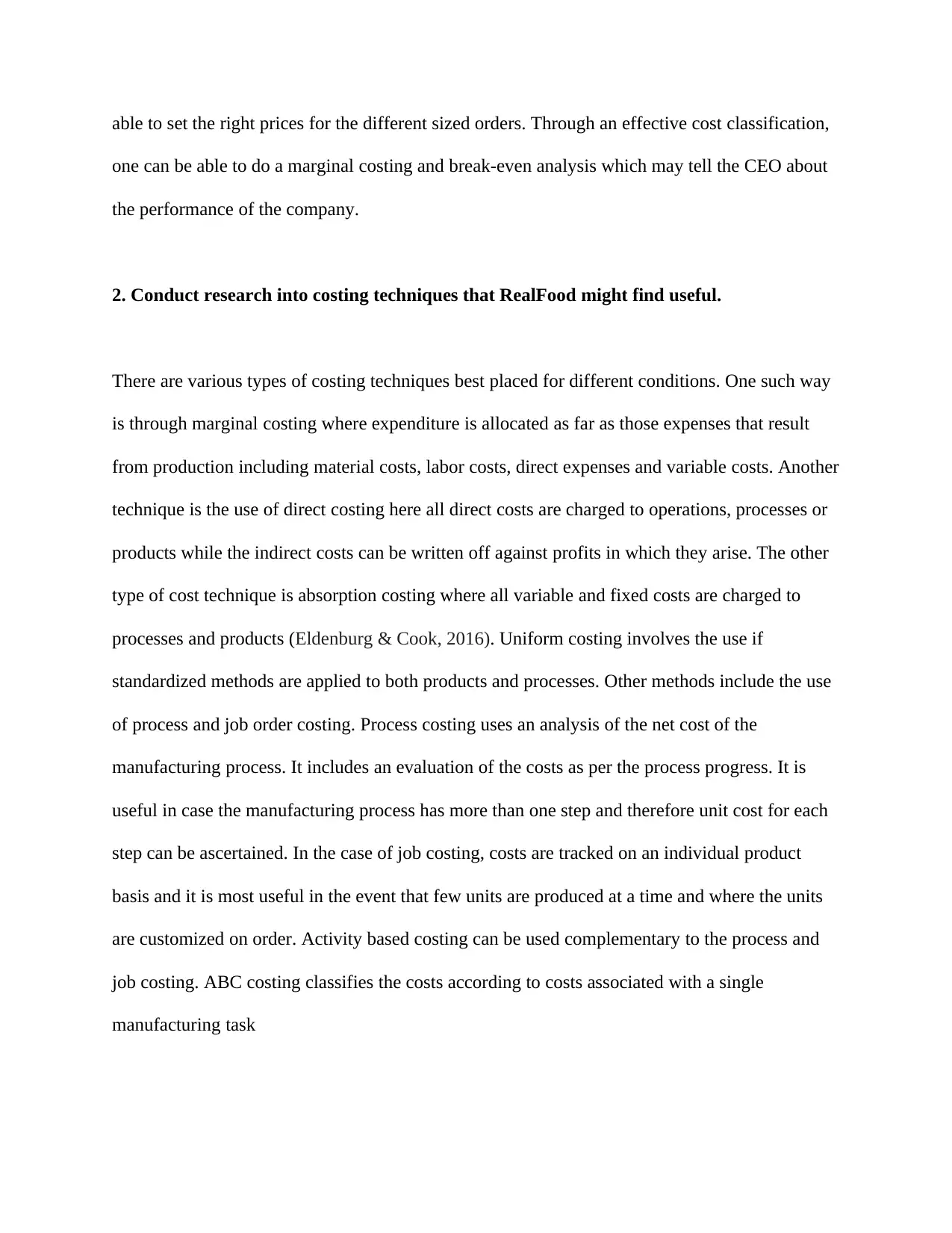
able to set the right prices for the different sized orders. Through an effective cost classification,
one can be able to do a marginal costing and break-even analysis which may tell the CEO about
the performance of the company.
2. Conduct research into costing techniques that RealFood might find useful.
There are various types of costing techniques best placed for different conditions. One such way
is through marginal costing where expenditure is allocated as far as those expenses that result
from production including material costs, labor costs, direct expenses and variable costs. Another
technique is the use of direct costing here all direct costs are charged to operations, processes or
products while the indirect costs can be written off against profits in which they arise. The other
type of cost technique is absorption costing where all variable and fixed costs are charged to
processes and products (Eldenburg & Cook, 2016). Uniform costing involves the use if
standardized methods are applied to both products and processes. Other methods include the use
of process and job order costing. Process costing uses an analysis of the net cost of the
manufacturing process. It includes an evaluation of the costs as per the process progress. It is
useful in case the manufacturing process has more than one step and therefore unit cost for each
step can be ascertained. In the case of job costing, costs are tracked on an individual product
basis and it is most useful in the event that few units are produced at a time and where the units
are customized on order. Activity based costing can be used complementary to the process and
job costing. ABC costing classifies the costs according to costs associated with a single
manufacturing task
one can be able to do a marginal costing and break-even analysis which may tell the CEO about
the performance of the company.
2. Conduct research into costing techniques that RealFood might find useful.
There are various types of costing techniques best placed for different conditions. One such way
is through marginal costing where expenditure is allocated as far as those expenses that result
from production including material costs, labor costs, direct expenses and variable costs. Another
technique is the use of direct costing here all direct costs are charged to operations, processes or
products while the indirect costs can be written off against profits in which they arise. The other
type of cost technique is absorption costing where all variable and fixed costs are charged to
processes and products (Eldenburg & Cook, 2016). Uniform costing involves the use if
standardized methods are applied to both products and processes. Other methods include the use
of process and job order costing. Process costing uses an analysis of the net cost of the
manufacturing process. It includes an evaluation of the costs as per the process progress. It is
useful in case the manufacturing process has more than one step and therefore unit cost for each
step can be ascertained. In the case of job costing, costs are tracked on an individual product
basis and it is most useful in the event that few units are produced at a time and where the units
are customized on order. Activity based costing can be used complementary to the process and
job costing. ABC costing classifies the costs according to costs associated with a single
manufacturing task
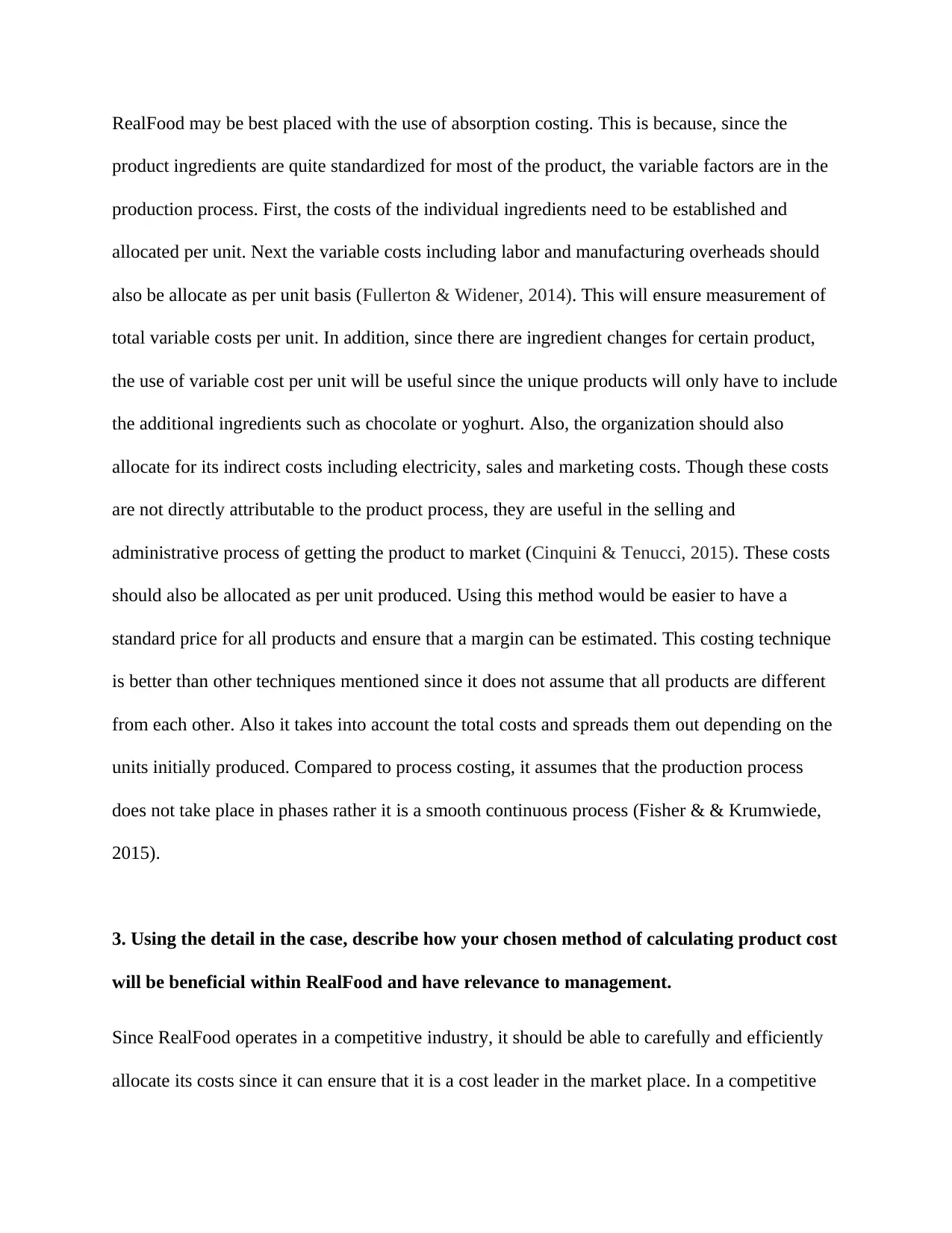
RealFood may be best placed with the use of absorption costing. This is because, since the
product ingredients are quite standardized for most of the product, the variable factors are in the
production process. First, the costs of the individual ingredients need to be established and
allocated per unit. Next the variable costs including labor and manufacturing overheads should
also be allocate as per unit basis (Fullerton & Widener, 2014). This will ensure measurement of
total variable costs per unit. In addition, since there are ingredient changes for certain product,
the use of variable cost per unit will be useful since the unique products will only have to include
the additional ingredients such as chocolate or yoghurt. Also, the organization should also
allocate for its indirect costs including electricity, sales and marketing costs. Though these costs
are not directly attributable to the product process, they are useful in the selling and
administrative process of getting the product to market (Cinquini & Tenucci, 2015). These costs
should also be allocated as per unit produced. Using this method would be easier to have a
standard price for all products and ensure that a margin can be estimated. This costing technique
is better than other techniques mentioned since it does not assume that all products are different
from each other. Also it takes into account the total costs and spreads them out depending on the
units initially produced. Compared to process costing, it assumes that the production process
does not take place in phases rather it is a smooth continuous process (Fisher & & Krumwiede,
2015).
3. Using the detail in the case, describe how your chosen method of calculating product cost
will be beneficial within RealFood and have relevance to management.
Since RealFood operates in a competitive industry, it should be able to carefully and efficiently
allocate its costs since it can ensure that it is a cost leader in the market place. In a competitive
product ingredients are quite standardized for most of the product, the variable factors are in the
production process. First, the costs of the individual ingredients need to be established and
allocated per unit. Next the variable costs including labor and manufacturing overheads should
also be allocate as per unit basis (Fullerton & Widener, 2014). This will ensure measurement of
total variable costs per unit. In addition, since there are ingredient changes for certain product,
the use of variable cost per unit will be useful since the unique products will only have to include
the additional ingredients such as chocolate or yoghurt. Also, the organization should also
allocate for its indirect costs including electricity, sales and marketing costs. Though these costs
are not directly attributable to the product process, they are useful in the selling and
administrative process of getting the product to market (Cinquini & Tenucci, 2015). These costs
should also be allocated as per unit produced. Using this method would be easier to have a
standard price for all products and ensure that a margin can be estimated. This costing technique
is better than other techniques mentioned since it does not assume that all products are different
from each other. Also it takes into account the total costs and spreads them out depending on the
units initially produced. Compared to process costing, it assumes that the production process
does not take place in phases rather it is a smooth continuous process (Fisher & & Krumwiede,
2015).
3. Using the detail in the case, describe how your chosen method of calculating product cost
will be beneficial within RealFood and have relevance to management.
Since RealFood operates in a competitive industry, it should be able to carefully and efficiently
allocate its costs since it can ensure that it is a cost leader in the market place. In a competitive
⊘ This is a preview!⊘
Do you want full access?
Subscribe today to unlock all pages.

Trusted by 1+ million students worldwide
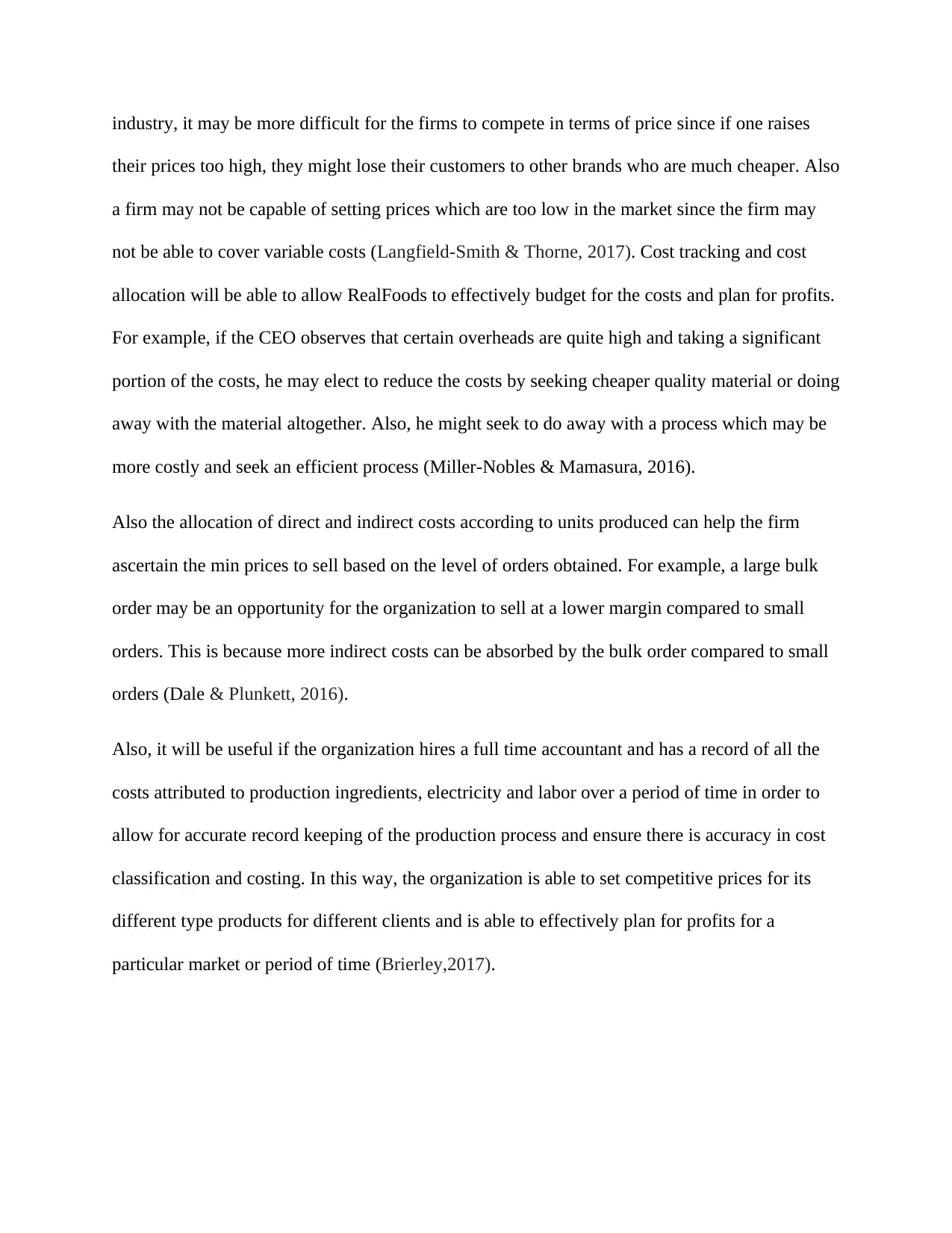
industry, it may be more difficult for the firms to compete in terms of price since if one raises
their prices too high, they might lose their customers to other brands who are much cheaper. Also
a firm may not be capable of setting prices which are too low in the market since the firm may
not be able to cover variable costs (Langfield-Smith & Thorne, 2017). Cost tracking and cost
allocation will be able to allow RealFoods to effectively budget for the costs and plan for profits.
For example, if the CEO observes that certain overheads are quite high and taking a significant
portion of the costs, he may elect to reduce the costs by seeking cheaper quality material or doing
away with the material altogether. Also, he might seek to do away with a process which may be
more costly and seek an efficient process (Miller-Nobles & Mamasura, 2016).
Also the allocation of direct and indirect costs according to units produced can help the firm
ascertain the min prices to sell based on the level of orders obtained. For example, a large bulk
order may be an opportunity for the organization to sell at a lower margin compared to small
orders. This is because more indirect costs can be absorbed by the bulk order compared to small
orders (Dale & Plunkett, 2016).
Also, it will be useful if the organization hires a full time accountant and has a record of all the
costs attributed to production ingredients, electricity and labor over a period of time in order to
allow for accurate record keeping of the production process and ensure there is accuracy in cost
classification and costing. In this way, the organization is able to set competitive prices for its
different type products for different clients and is able to effectively plan for profits for a
particular market or period of time (Brierley,2017).
their prices too high, they might lose their customers to other brands who are much cheaper. Also
a firm may not be capable of setting prices which are too low in the market since the firm may
not be able to cover variable costs (Langfield-Smith & Thorne, 2017). Cost tracking and cost
allocation will be able to allow RealFoods to effectively budget for the costs and plan for profits.
For example, if the CEO observes that certain overheads are quite high and taking a significant
portion of the costs, he may elect to reduce the costs by seeking cheaper quality material or doing
away with the material altogether. Also, he might seek to do away with a process which may be
more costly and seek an efficient process (Miller-Nobles & Mamasura, 2016).
Also the allocation of direct and indirect costs according to units produced can help the firm
ascertain the min prices to sell based on the level of orders obtained. For example, a large bulk
order may be an opportunity for the organization to sell at a lower margin compared to small
orders. This is because more indirect costs can be absorbed by the bulk order compared to small
orders (Dale & Plunkett, 2016).
Also, it will be useful if the organization hires a full time accountant and has a record of all the
costs attributed to production ingredients, electricity and labor over a period of time in order to
allow for accurate record keeping of the production process and ensure there is accuracy in cost
classification and costing. In this way, the organization is able to set competitive prices for its
different type products for different clients and is able to effectively plan for profits for a
particular market or period of time (Brierley,2017).
Paraphrase This Document
Need a fresh take? Get an instant paraphrase of this document with our AI Paraphraser
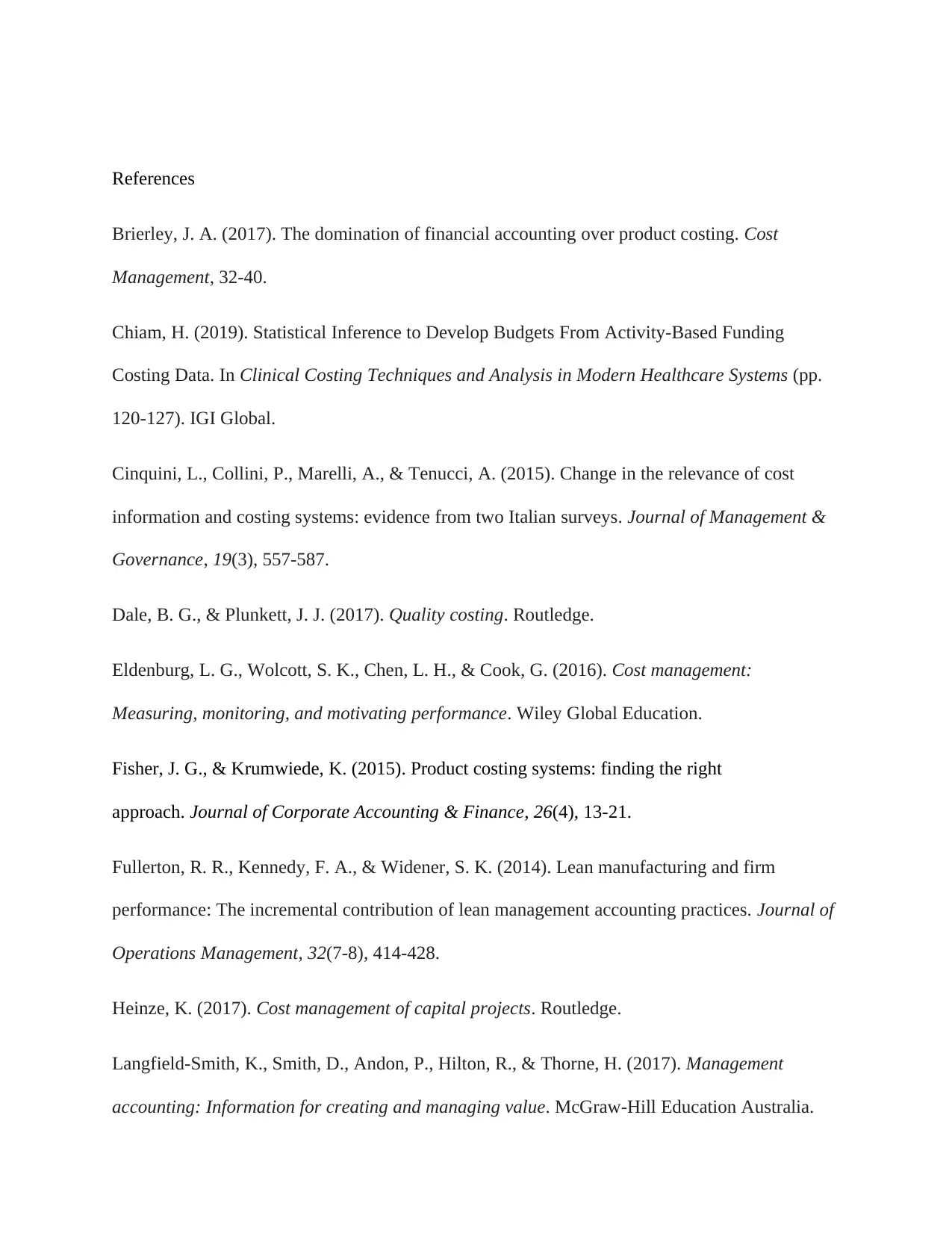
References
Brierley, J. A. (2017). The domination of financial accounting over product costing. Cost
Management, 32-40.
Chiam, H. (2019). Statistical Inference to Develop Budgets From Activity-Based Funding
Costing Data. In Clinical Costing Techniques and Analysis in Modern Healthcare Systems (pp.
120-127). IGI Global.
Cinquini, L., Collini, P., Marelli, A., & Tenucci, A. (2015). Change in the relevance of cost
information and costing systems: evidence from two Italian surveys. Journal of Management &
Governance, 19(3), 557-587.
Dale, B. G., & Plunkett, J. J. (2017). Quality costing. Routledge.
Eldenburg, L. G., Wolcott, S. K., Chen, L. H., & Cook, G. (2016). Cost management:
Measuring, monitoring, and motivating performance. Wiley Global Education.
Fisher, J. G., & Krumwiede, K. (2015). Product costing systems: finding the right
approach. Journal of Corporate Accounting & Finance, 26(4), 13-21.
Fullerton, R. R., Kennedy, F. A., & Widener, S. K. (2014). Lean manufacturing and firm
performance: The incremental contribution of lean management accounting practices. Journal of
Operations Management, 32(7-8), 414-428.
Heinze, K. (2017). Cost management of capital projects. Routledge.
Langfield-Smith, K., Smith, D., Andon, P., Hilton, R., & Thorne, H. (2017). Management
accounting: Information for creating and managing value. McGraw-Hill Education Australia.
Brierley, J. A. (2017). The domination of financial accounting over product costing. Cost
Management, 32-40.
Chiam, H. (2019). Statistical Inference to Develop Budgets From Activity-Based Funding
Costing Data. In Clinical Costing Techniques and Analysis in Modern Healthcare Systems (pp.
120-127). IGI Global.
Cinquini, L., Collini, P., Marelli, A., & Tenucci, A. (2015). Change in the relevance of cost
information and costing systems: evidence from two Italian surveys. Journal of Management &
Governance, 19(3), 557-587.
Dale, B. G., & Plunkett, J. J. (2017). Quality costing. Routledge.
Eldenburg, L. G., Wolcott, S. K., Chen, L. H., & Cook, G. (2016). Cost management:
Measuring, monitoring, and motivating performance. Wiley Global Education.
Fisher, J. G., & Krumwiede, K. (2015). Product costing systems: finding the right
approach. Journal of Corporate Accounting & Finance, 26(4), 13-21.
Fullerton, R. R., Kennedy, F. A., & Widener, S. K. (2014). Lean manufacturing and firm
performance: The incremental contribution of lean management accounting practices. Journal of
Operations Management, 32(7-8), 414-428.
Heinze, K. (2017). Cost management of capital projects. Routledge.
Langfield-Smith, K., Smith, D., Andon, P., Hilton, R., & Thorne, H. (2017). Management
accounting: Information for creating and managing value. McGraw-Hill Education Australia.
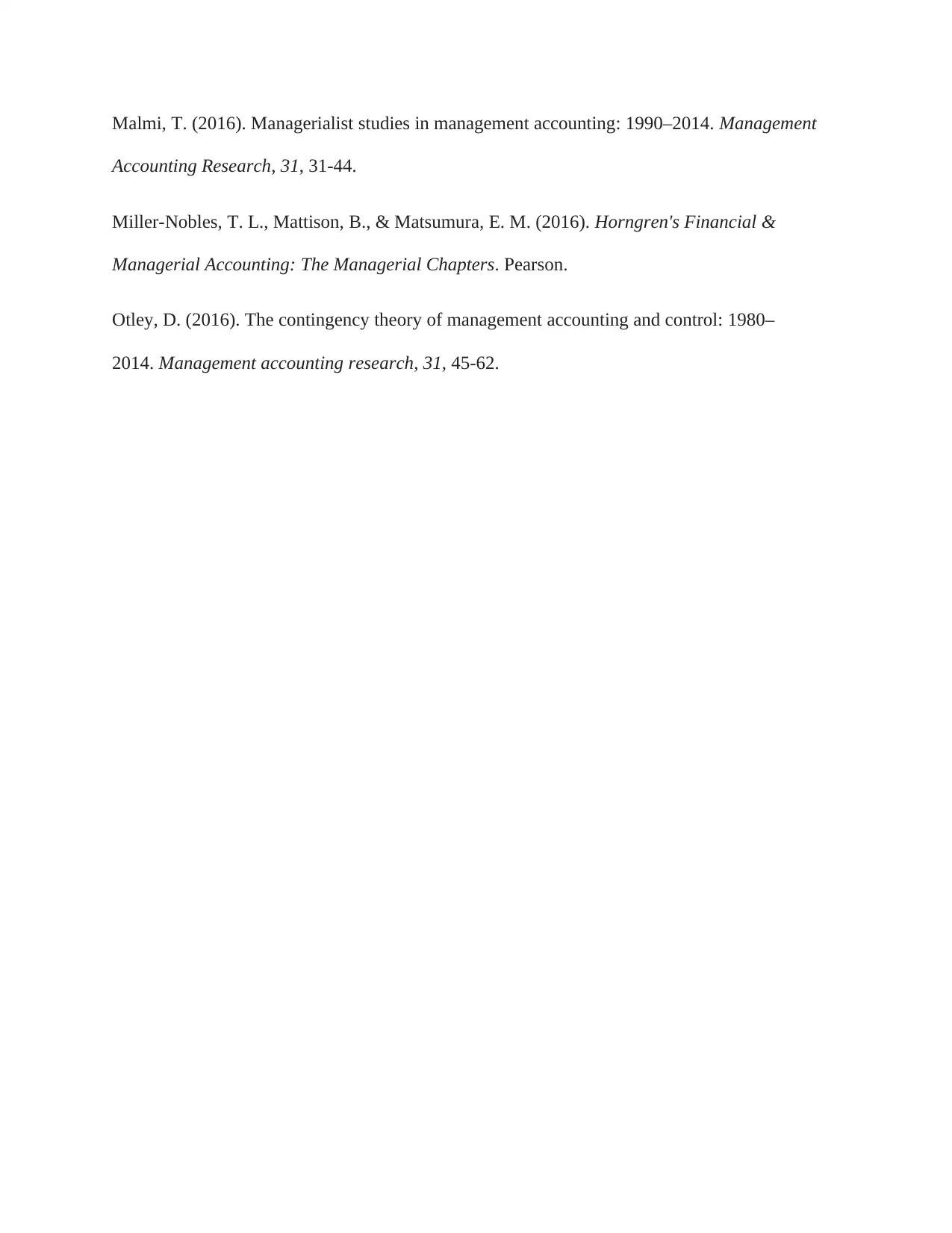
Malmi, T. (2016). Managerialist studies in management accounting: 1990–2014. Management
Accounting Research, 31, 31-44.
Miller-Nobles, T. L., Mattison, B., & Matsumura, E. M. (2016). Horngren's Financial &
Managerial Accounting: The Managerial Chapters. Pearson.
Otley, D. (2016). The contingency theory of management accounting and control: 1980–
2014. Management accounting research, 31, 45-62.
Accounting Research, 31, 31-44.
Miller-Nobles, T. L., Mattison, B., & Matsumura, E. M. (2016). Horngren's Financial &
Managerial Accounting: The Managerial Chapters. Pearson.
Otley, D. (2016). The contingency theory of management accounting and control: 1980–
2014. Management accounting research, 31, 45-62.
⊘ This is a preview!⊘
Do you want full access?
Subscribe today to unlock all pages.

Trusted by 1+ million students worldwide
1 out of 6
Related Documents
Your All-in-One AI-Powered Toolkit for Academic Success.
+13062052269
info@desklib.com
Available 24*7 on WhatsApp / Email
![[object Object]](/_next/static/media/star-bottom.7253800d.svg)
Unlock your academic potential
Copyright © 2020–2025 A2Z Services. All Rights Reserved. Developed and managed by ZUCOL.




